2018 MERCEDES-BENZ SLC ROADSTER display
[x] Cancel search: displayPage 33 of 298
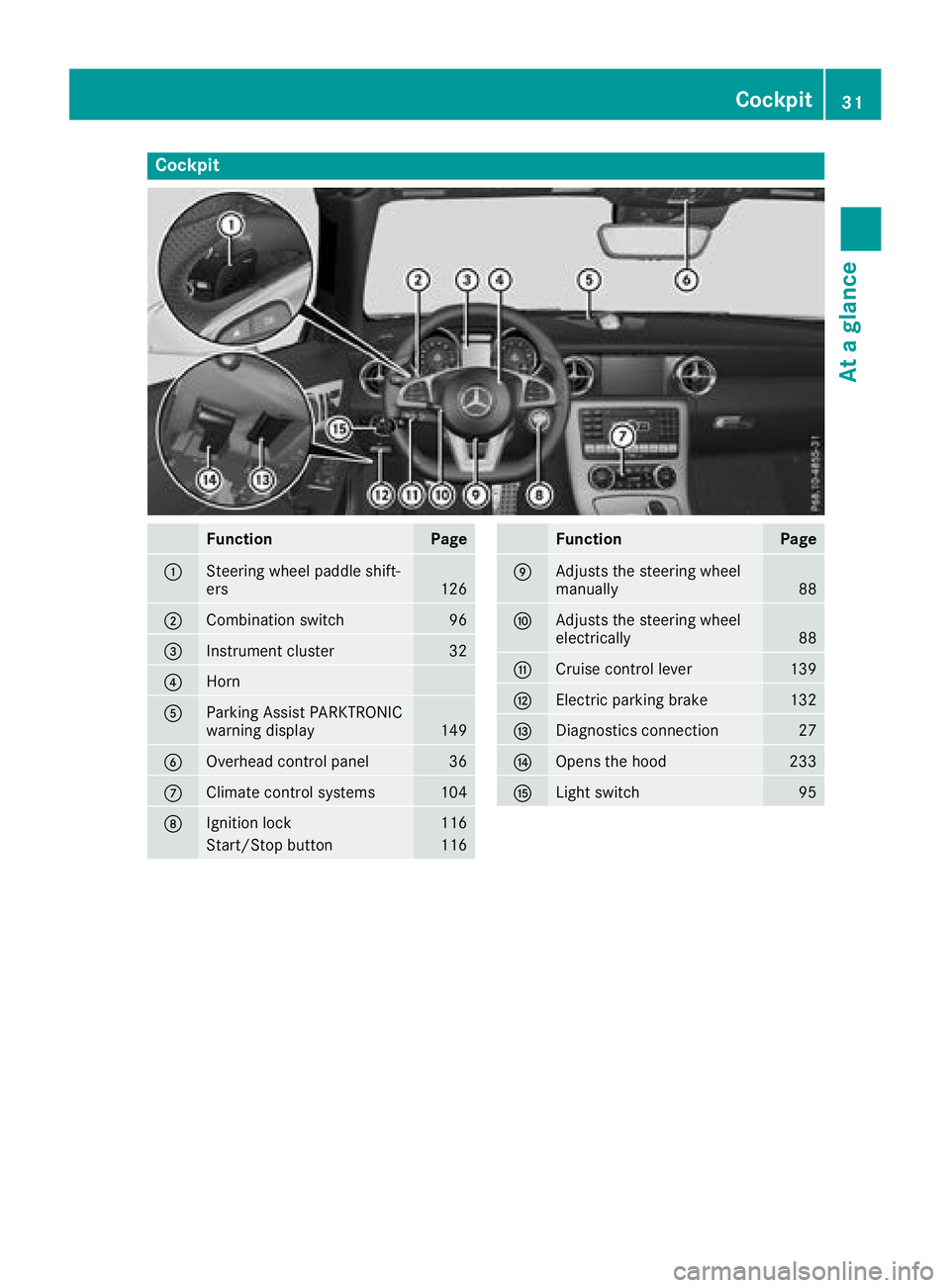
Cockpit
FunctionPage
:Steering wheel paddle shift-
ers126
;Combination switch96
=Instrumentcluster32
?Horn
AParking Assist PARKTRONIC
warning display149
BOverhead control panel36
CClimatecontrol systems104
DIgnition lock116
Start/Sto pbutton116
FunctionPage
EAdjusts th esteering wheel
manually88
FAdjusts th esteering wheel
electrically88
GCruis econtrol lever139
HElectric parking brake132
IDiagnostics connection27
JOpenst hehood233
KLights witch95
Cockpit31
Atag lance
Page 34 of 298
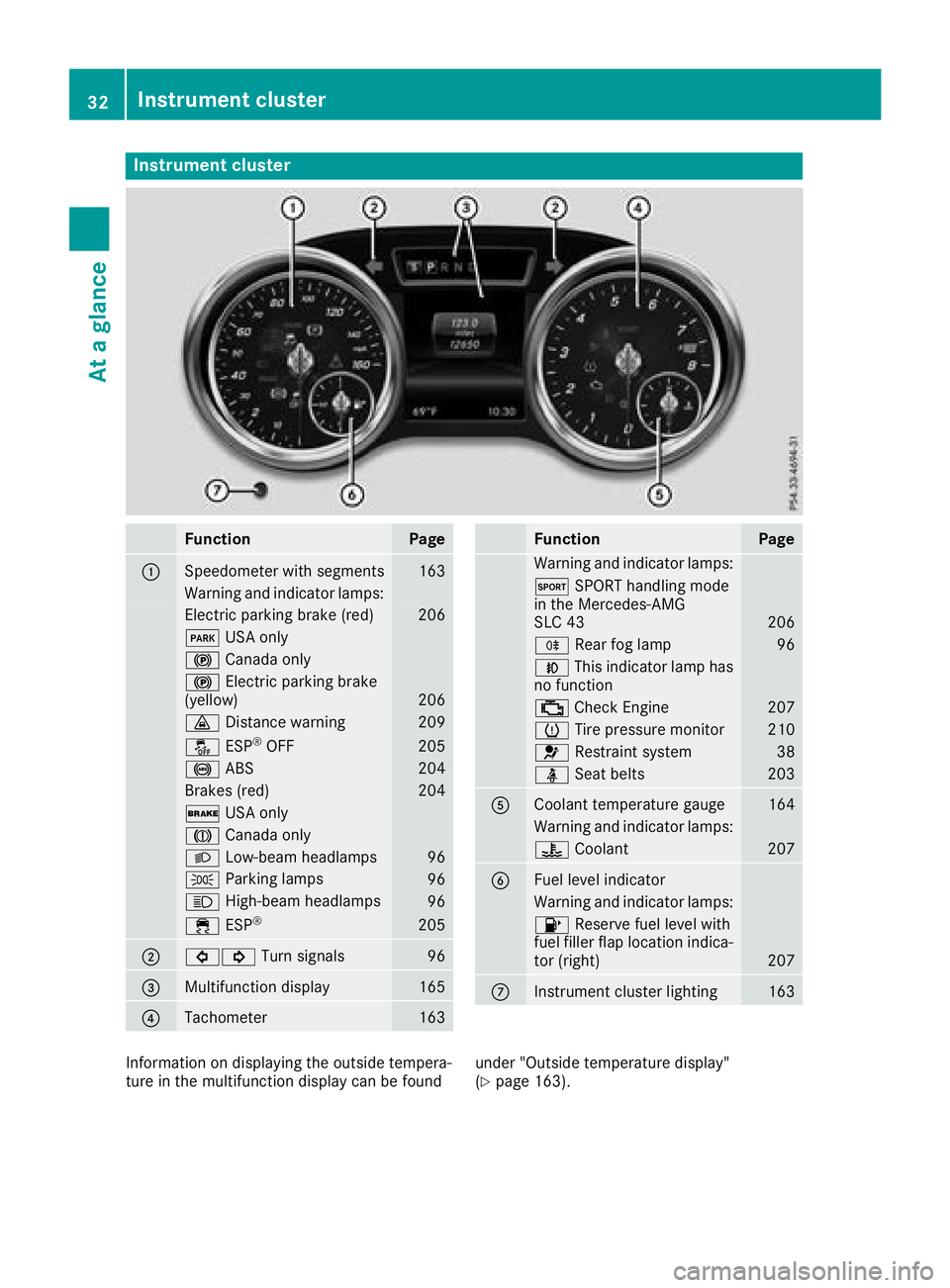
Instrumentcluster
FunctionPag e
:Speedometer wit hsegments163
Warning and indicator lamps:
Electric parking brak e(red)20 6
F USAo nly
! Canad aonly
! Electric parking brak e
(yellow)20 6
· Distanc ewarning209
å ESP®OF F205
! ABS204
Brake s(red)20 4
$ USAo nly
J Canad aonly
L Low-beam headlamps96
TParking lamp s96
KHigh-beam headlamps96
÷ESP®20 5
;#! Turn signals96
=Multifunction display165
?Tachometer163
FunctionPag e
Warning and indicator lamps:
M SPORT handlin gmode
in th eMercedes-AM G
SL C4 3
206
R Rear fog lamp96
NThis indicator lamp has
no function
; CheckEngine20 7
h Tirep ressur emonitor210
6 Restrain tsystem38
ü Seat belt s203
ACoolan ttem perature gauge164
Warning and indicator lamps:
? Coolan t207
BFue llevel indicator
Warning and indicator lamps:
8 Reserve fuel level wit h
fuel filler flap location indica-
to r( right )
207
CInstrumen tcluste rlighting16 3
Information on displayin gthe outside tempera-
tur eint hemultifunction display can be foun dunder "Outside temperature display"
(Ypage 163).
32Instrumen
tcluster
At ag lance
Page 35 of 298
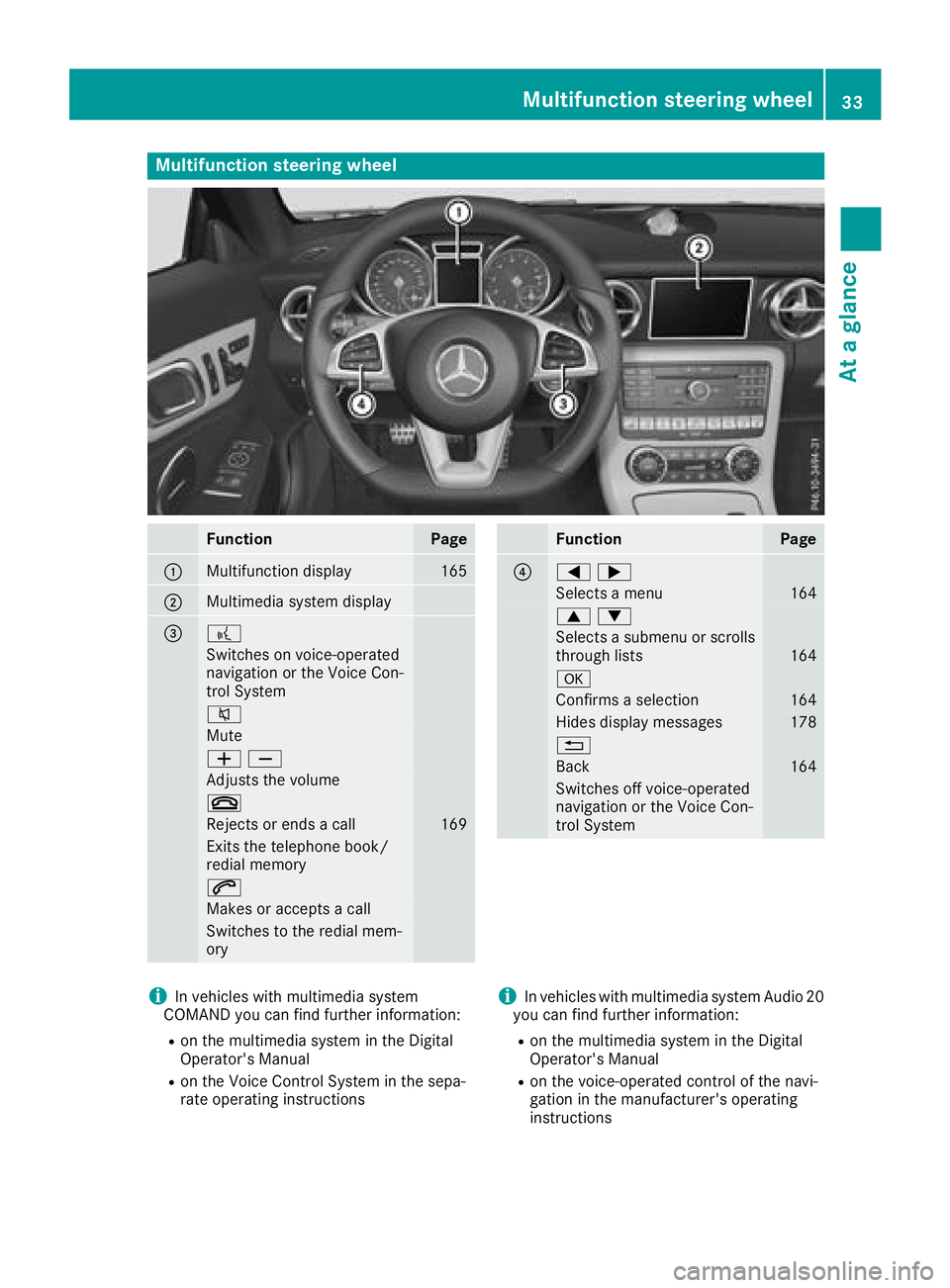
Multifunction steering wheel
FunctionPage
:Multifunction display165
;Multimediasystem display
=?
Switches on voice-operated
navigation or the Voice Con-
trol System
8
Mute
WX
Adjusts the volume
~
Rejects or end sacall169
Exits the telephone book/
redia lmemory
6
Makes or accepts acall
Switchestot he redialmem-
ory
FunctionPage
?=;
Selects amenu164
9:
Selects asubmenu or scrolls
through lists164
a
Confirm saselection164
Hides display messages178
%
Back164
Switches off voice-operated
navigation or the Voice Con-
trol System
iIn vehicles with multimedi asystem
COMAND yo ucan find further information:
Ron the multimedi asystem in the Digital
Operator's Manual
Ron the Voice Control System in the sepa-
rate operating instructions
iIn vehicles with multimedi asystem Audio 20
yo uc an find further information:
Ron the multimedi asystem in the Digital
Operator's Manual
Ron the voice-operated control of the navi-
gation in the manufacturer'so perating
instructions
Multifunctions teering wheel33
Atag lance
Page 41 of 298
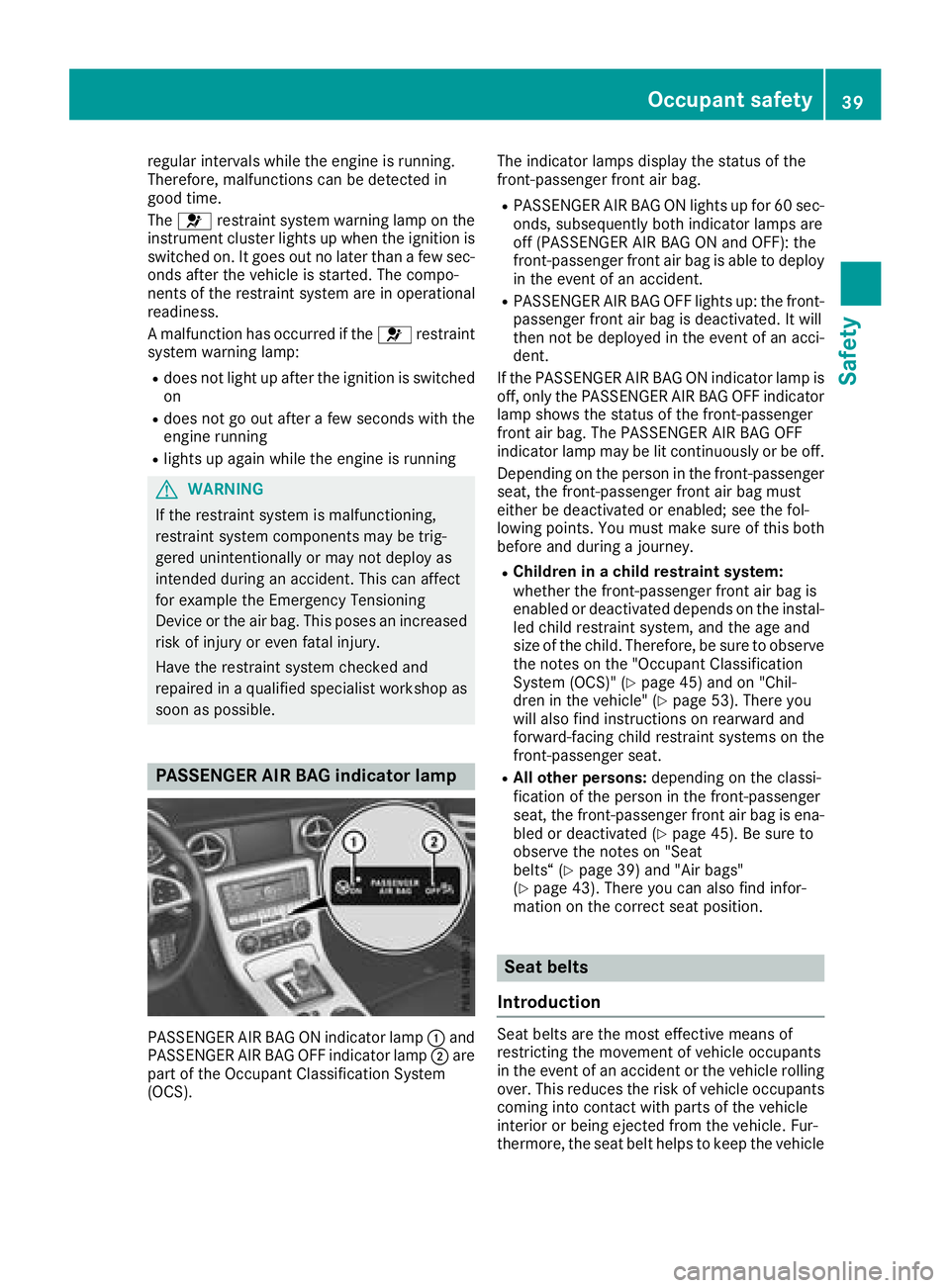
regular intervalswhile the engine is running.
Therefore, malfunctions can be detected in
good time.
The 6 restraint system warning lamp on the
instrument cluster lights up when the ignitio nis
switched on. It goes out no later than afew sec-
onds after the vehicleiss tarted. The compo-
nents of the restraint system are in operational
readiness.
Am alfunction has occurred if the 6restraint
system warning lamp:
Rdoes not light up after the ignitio nisswitched
on
Rdoes not go out after afew seconds with the
engine running
Rlights up again while the engine is running
GWARNING
If the restraint system is malfunctioning,
restraint system components may be trig-
gered unintentionally or may not deploy as
intended during an accident. This can affect
for examplet he Emergency Tensioning
Device or the air bag .This poses an increased
risk of injury or even fatal injury.
Have the restraint system checked and
repaired in aqualified specialist workshop as
soon as possible.
PASSENGER AI RBAG indicator lamp
PASSENGER AIR BAG ON indicator lamp :and
PASSENGER AIR BAG OFF indicator lamp ;are
part of the Occupant Classification System
(OCS). The indicator lamp
sdisplay the status of the
front-passenge rfront air bag.
RPASSENGER AIR BAG ON lights up for 60 sec-
onds, subsequently both indicator lamp sare
off (PASSENGER AIR BAG ON and OFF): the
front-passenge rfront air bag is abl etodeploy
in the event of an accident.
RPASSENGER AIR BAG OFF lights up: the front-
passenger front air bag is deactivated. It will
then not be deploye dinthe event of an acci-
dent.
If the PASSENGER AIR BAG ON indicator lamp is
off, only the PASSENGER AIR BAG OFF indicator lamp shows the status of the front-passenger
front air bag .The PASSENGER AIR BAG OFF
indicator lamp may be lit continuously or be off.
Depending on the person in the front-passenger
seat, the front-passenge rfront air bag must
either be deactivated or enabled; see the fol-
lowing points. You must make sure of this both
before and during ajourney.
RChildren in achildr estraint system:
whethert he front-passenge rfront air bag is
enabled or deactivated depends on the instal- led child restraint system, and the age and
size of the child.T herefore, be sure to observe
the notes on the "Occupant Classification
System (OCS)" (
Ypag e45) and on "Chil-
dren in the vehicle" (Ypag e53). There you
wil lalsof ind instructions on rearward and
forward-facing child restraint systems on the
front-passenge rseat.
RAll other persons: depending on the classi-
ficatio nofthe person in the front-passenger
seat, the front-passenge rfront air bag is ena-
bled or deactivated (
Ypag e45). Be sure to
observe the notes on "Seat
belts“ (
Ypag e39) and "Air bags"
(Ypag e43).T here you can als ofind infor-
mation on the correct seat position.
Seat belts
Introduction
Seat belts are the most effective means of
restricting the movement of vehicleo ccupants
in the event of an accident or the vehicler olling
over. This reduces the risk of vehicleo ccupants
coming into contact with parts of the vehicle
interior or being ejected from the vehicle. Fur-
thermore, the seat belt helpstok eep the vehicle
Occupant safety39
Safety
Z
Page 48 of 298

The system does not deactivate:
Rthe side impact air bag
Rthe headbag
Rthe Emergency TensioningDevices
Requirements
To be classified correctly, the front passenger
must sit:
Rwith the seat belt fastened correctly
Rin an almost upright position with their back
against the seat backrest
Rwith their feet restin gonthe floor, if possible
If the front passenger does not observe these
conditions, OCS may produce afalse classifica-
tion, e.g. because the front passenger:
Rtransfers their weight by supporting them-
selves on avehicle armrest
Rsits in such away that their weight is raised
from the seat cushion
If you install achild restraint system on the
front-passenger seat, be sure to observe the
correctp ositioningofthe child restraint system.
Never place object sunder or behind the child
restraint system, e.g. acushion. The entir ebase
of the child restraint system must alwaysr est on
the seat cushion of the front-passenger seat.
The backrest of the forward-facing child
restraint system must lie as flat as possible
against the backrest of the front-passenger
seat.
The child restraint system must not touch the
roof or be subjected to aload by the head
restraint. Adjust the angle of the seat backrest
and the head restraint position accordingly.
Only then can OCS be guaranteed to function
correctly. Always observe the child restraint sys-
tem manufacturer's installation and operating
instructions.
Occupant Classification System opera-
tion (OCS)
:PASSENGER AIR BAG ON indicator lamp
;PASSENGER AIR BAG OFF indicator lamp
The indicator lamps inform you whether the
front-passenger front air bag is deactivated or
enabled.
XPress the Start/Stop button once or twice, or
turn the SmartKey to position 1or2 in the
ignition lock.
The system carries out self-diagnostics.
The PASSENGER AIR BAG OFF and PASSENGER AIR BAG ON indicator lamps must light up simul-
taneously for approximately six seconds.
The indicator lamps display the status of the
front-passenger front air bag.
RPASSENGER AIR BAG ON lights up for 60 sec-
onds, subsequently both indicator lamps are
off (PASSENGER AIR BAG ON and OFF): the
front-passenger front air bag is able to deploy
in the event of an accident.
RPASSENGER AIR BAG OFF lights up: the front-
passenger front air bag is deactivated. It will
then not be deployed in the event of an acci-
dent.
If the PASSENGER AIR BAG ON indicator lamp is
off, only the PASSENGER AIR BAG OFF indicator lamp shows the status of the front-passenger
front air bag. The PASSENGER AIR BAG OFF
indicator lamp may be lit continuously or be off.
If the status of the front-passenger front air bag
changes while the vehicle is in motion,ana ir bag
display message appears in the instrument clus-
ter (
Ypage 187). When the front-passenger
seat is occupied, alwaysp ay attention to the
PASSENGER AIR BAG OFF indicator lamp. Be
aware of the status of the front-passenger front air bag both before and during the journey.
46Occupant safety
Safety
Page 51 of 298
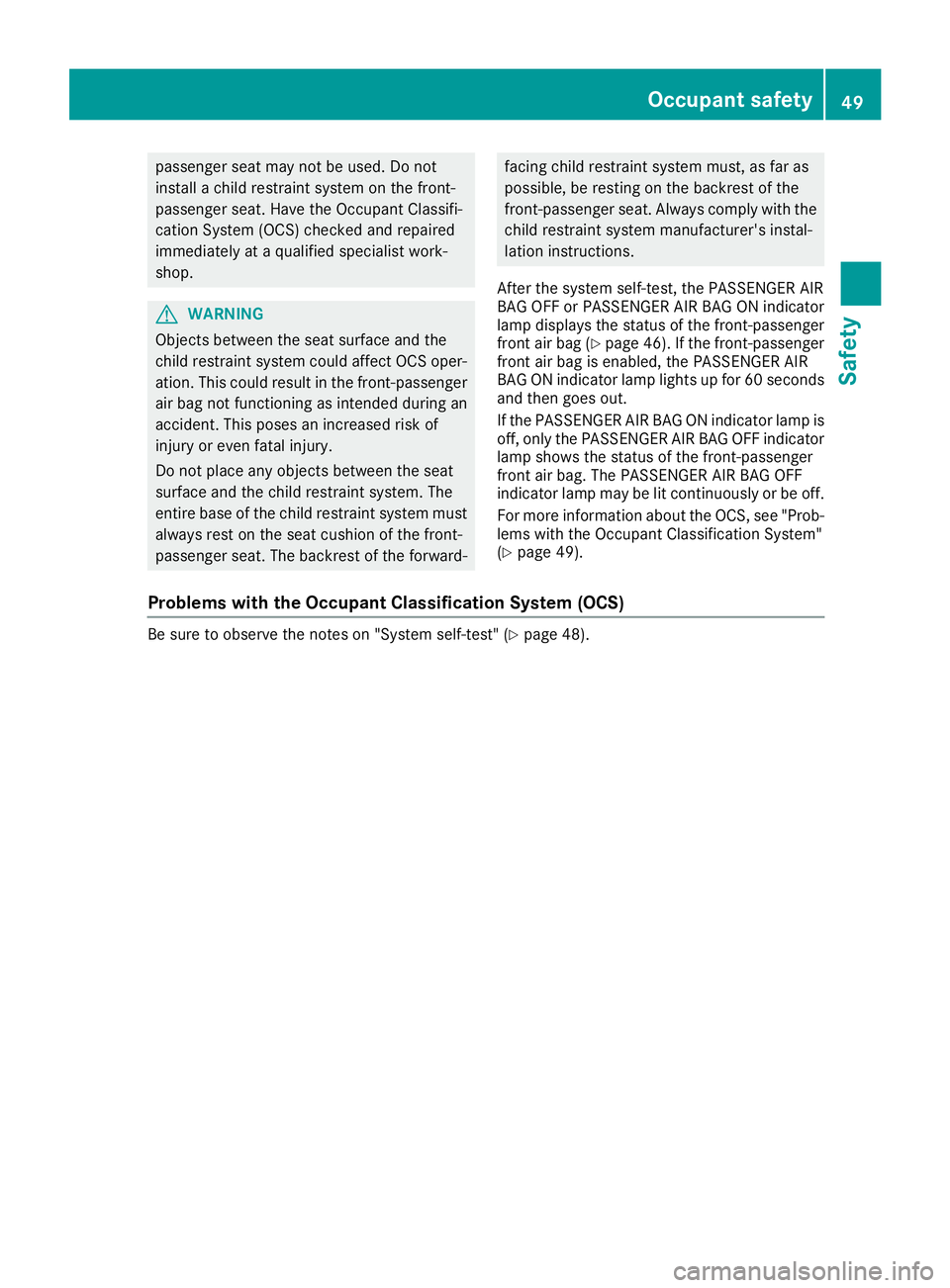
passenger seat may not be used. Do not
installachild restraint system on the front-
passenger seat. Have the Occupant Classifi-
cation System (OCS) checked and repaired
immediately at aqualified specialist work-
shop.
GWARNING
Objects between the seat surface and the
child restraint system could affect OCS oper- ation. This could result in the front-passenger
air bag not functioning as intended during an
accident. This poses an increased risk of
injury or even fatal injury.
Do not place any objects between the seat
surface and the child restraint system. The
entire base of the child restraint system must
always rest on the seat cushion of the front-
passenger seat. The backrest of the forward-
facingc hild restraint system must, as far as
possible, be resting on the backrest of the
front-passenger seat. Always comply with the
child restraint system manufacturer's instal-
lation instructions.
After the system self-test, the PASSENGER AIR
BAGO FF or PASSENGER AIR BAGONi ndicator
lamp displays the status of the front-passenger
fronta ir bag (
Ypage 46). If the front-passenger
fronta ir bag is enabled, the PASSENGER AIR
BAGONi ndicator lamp lights up for 60 seconds
and then goes out.
If the PASSENGER AIR BAGONi ndicator lamp is
off, only the PASSENGER AIR BAGO FF indicator
lamp shows the status of the front-passenger
fronta ir bag. The PASSENGER AIR BAGO FF
indicator lamp may be lit continuously or be off.
For more information about the OCS, see "Prob-
lems with the Occupant Classification System"
(
Ypage 49).
Problems with the Occupant Classification System (OCS)
Be sure to observe the notes on "System self-test" (Ypage 48).
Occupant safety49
Safety
Z
Page 61 of 298
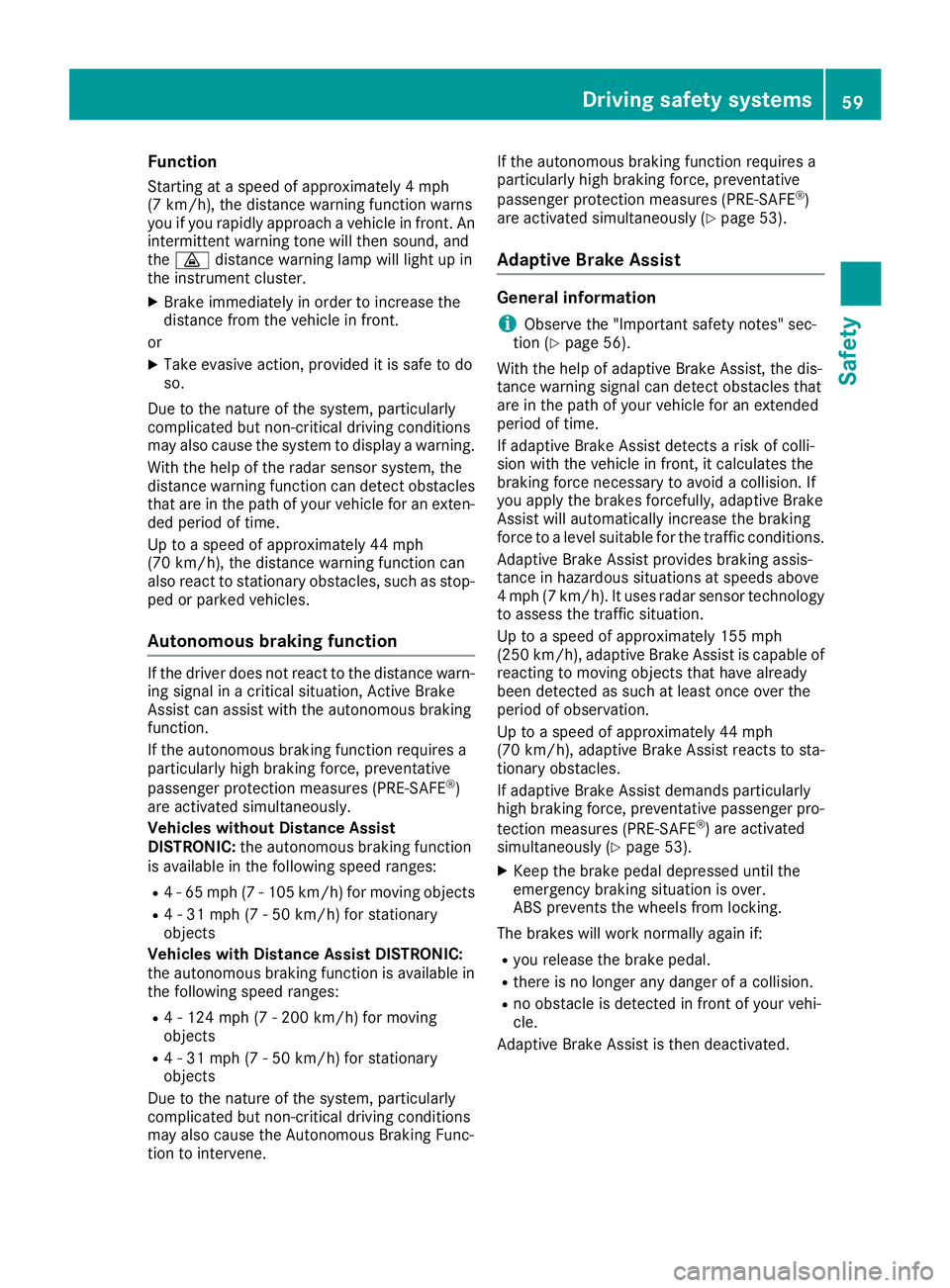
Function
Starting at aspeedofa pproximately 4mph
(7 km/h), th edistanc ewarning function warns
you ifyou rapid ly approachav ehicle in front. An
intermittentw arning tonewillthen sound, and
the · distancewarning lamp willlight up in
th ei nstrumen tcluster.
XBrake immediately inorder to increas ethe
dist ancefromt heveh icle in front.
or
XTakee vasive action,p rovide ditiss afe todo
so.
Due to th enature of th esystem, particularly
co mpli cated but non-critical driving conditions
may also caus ethe system to displayaw arning.
Witht hehelp of th eradar sensor system, the
dist ancewarning function can detect obstacles
that are inthep athofy our veh iclefor an exten-
ded period of time.
Up to aspeedofa pproximately 44 mph
(70 km/ h),t he distance warnin gfunction can
also react to stationary obstacles, such as stop-
ped or parked vehicles.
Autonomous braking function
If the driver does not react to the distance warn-
ing signal in acritical situation, Active Brake
Assis tcan assist with the autonomous braking
function.
If the autonomous brakin gfunction requires a
particularly high brakin gforce, preventative
passenger protection measures (PRE-SAFE
®)
are activated simultaneously.
Vehicles without Distance Assist
DISTRONIC: the autonomous brakin gfunction
is available in the following speed ranges:
R4-65m ph (7-105 km/ h)for moving objects
R4-31m ph (7-50km/h)for stationary
objects
Vehicles with Distance Assist DISTRONIC:
the autonomous braking function is available in
the following speedr anges:
R4-124 mph (7 -200 km/h )for moving
objects
R4-31m ph (7-50km/h)for stationary
objects
Due to the nature of the system ,particularly
complicated but non-critical driving conditions
may als ocaus ethe Autonomou sBraking Func-
tion to intervene. If the autonomous braking function requires a
particularly high braking force, preventative
passenger protection measures (PRE-SAFE
®)
are activated simultaneousl y(Ypage53).
Adaptive Brake Assist
General information
iObservet he "Important safety notes" sec-
tion (Ypag e56).
With the help of adaptive Brake Assist, the dis-
tance warning signalc an detect obstacles that
are in the path of you rvehiclef or an extended
period of time.
If adaptive Brake Assist detects arisk of colli-
sion with the vehicleinf ront, it calculatesthe
braking force necessary to avoi dacollision. If
you apply the brakes forcefully ,adaptive Brake
Assist wil lautomatically increas ethe braking
force to alevels uitabl efor the traffic conditions.
Adaptive Brake Assist provides braking assis-
tance in hazardouss ituations at speeds above
4m ph (7 km/h) .Itusesrada rsensor technology
to assess the traffic situation.
Up to aspeedofa pproximately 155 mph
(250 km/h) ,adaptive Brake Assist is capable of
reacting to moving objects that have already
been detected as such at least once over the
period of observation.
Up to aspeedofa pproximately 44 mph
(70 km/h), adaptive Brake Assist reacts to sta-
tionary obstacles.
If adaptive Brake Assist demands particularly
high braking force, preventative passenger pro-
tection measures (PRE-SAFE
®)a re activated
simultaneousl y(Ypage53).
XKeep the brake pedald epressed until the
emergency braking situation is over.
ABS prevents the wheels from locking.
The brakes wil lwork normally again if:
Ryou release the brake pedal.
Rthere is no longera ny dangerofacollision.
Rno obstacle is detected in front of you rvehi-
cle.
Adaptive Brake Assist is then deactivated.
Driving safety systems59
Safety
Z
Page 63 of 298
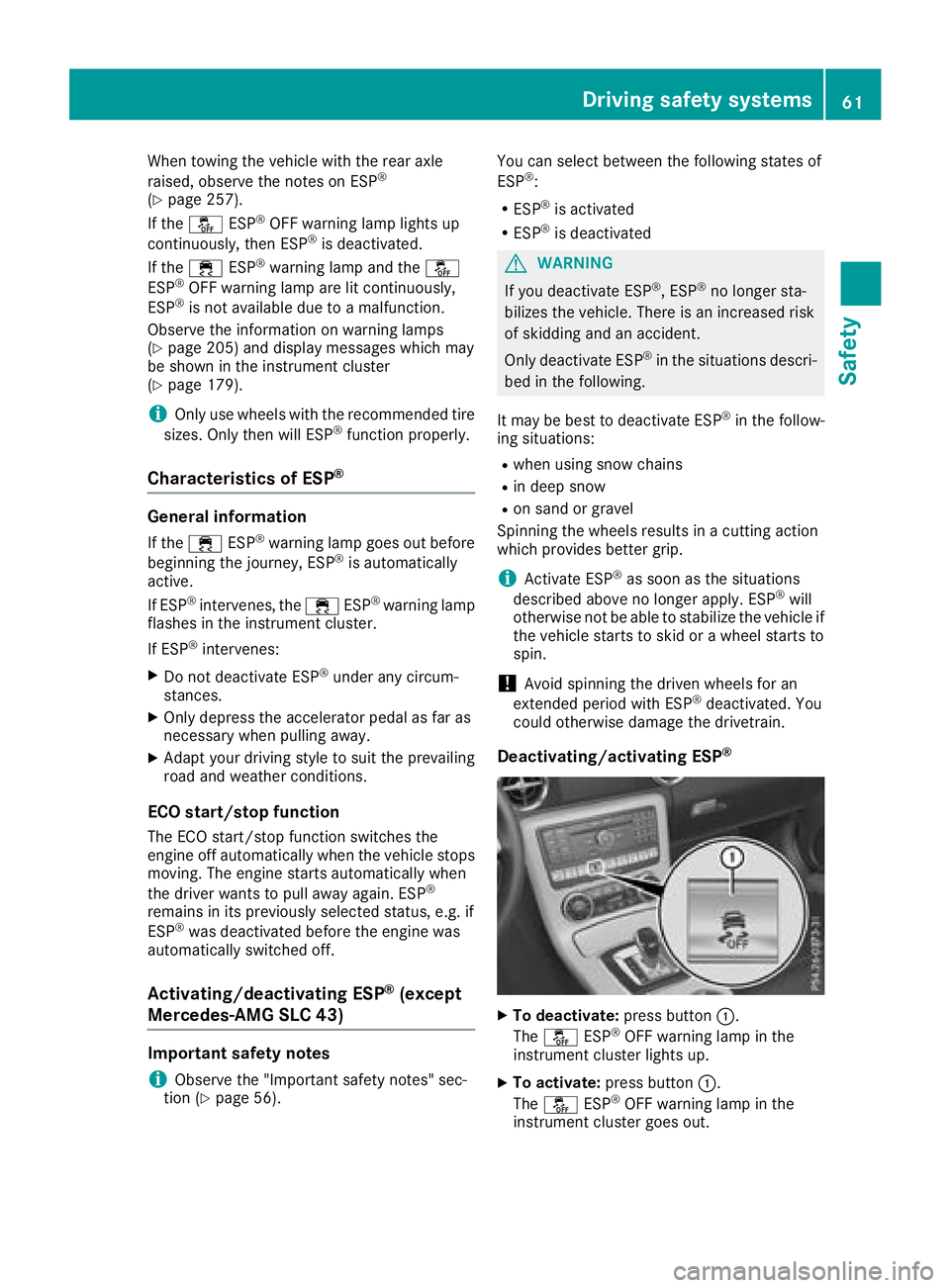
When towing the vehicle with the rear axle
raised, observe the notes on ESP®
(Ypage 257).
If the å ESP®OFF warning lamp lights up
continuously, then ESP®is deactivated.
If the ÷ ESP®warning lamp and the å
ESP®OFF warning lamp are lit continuously,
ESP®is not available due to amalfunction.
Observe the information on warning lamps
(
Ypage 205) and display messages which may
be shown in the instrument cluster
(
Ypage 179).
iOnly use wheels with the recommended tire
sizes. Only then will ESP®function properly.
Characteristics of ESP®
General information
If the ÷ ESP®warning lamp goes out before
beginnin gthe journey, ESP®is automatically
active.
If ESP
®intervenes, the ÷ESP®warning lamp
flashes in the instrument cluster.
If ESP
®intervenes:
XDo not deactivat eESP®under any circum-
stances.
XOnly depress the accelerator pedal as far as
necessary when pulling away.
XAdapt your driving style to suit the prevailing
road and weather conditions.
ECO start/stop function
The ECO start/stop function switches the
engine off automatically when the vehicle stops
moving. The engine start sautomatically when
the driver wants to pull away again. ESP
®
remains in its previously selected status, e.g. if
ESP®was deactivated before the engine was
automatically switched off.
Activating/deactivating ESP®(except
Mercedes-AMG SLC 43)
Important safety notes
iObserve the "Important safety notes" sec-
tion (Ypage 56). You can select between the following states of
ESP
®:
RESP®is activated
RESP®is deactivated
GWARNING
If you deactivat eESP
®,ESP®no longer sta-
bilizes the vehicle. There is an increased risk
of skidding and an accident.
Only deactivat eESP
®in the situation sdescri-
bed in the following.
It may be best to deactivat eESP
®in the follow-
ing situations:
Rwhen using snow chains
Rin deep snow
Ron sand or gravel
Spinning the wheels results in acutting action
which provides better grip.
iActivate ESP®as soon as the situations
described above no longer apply. ESP®will
otherwise not be able to stabilize the vehicle if
the vehicle start stoskid or awheel start sto
spin.
!Avoid spinnin gthe driven wheels for an
extended period with ESP®deactivated. You
could otherwise damage the drivetrain.
Deactivating/activating ESP®
XTo deactivate: press button:.
The å ESP®OFF warning lamp in the
instrument cluster lights up.
XTo activate: press button :.
The å ESP®OFF warning lamp in the
instrument cluster goes out.
Driving safety systems61
Safety
Z